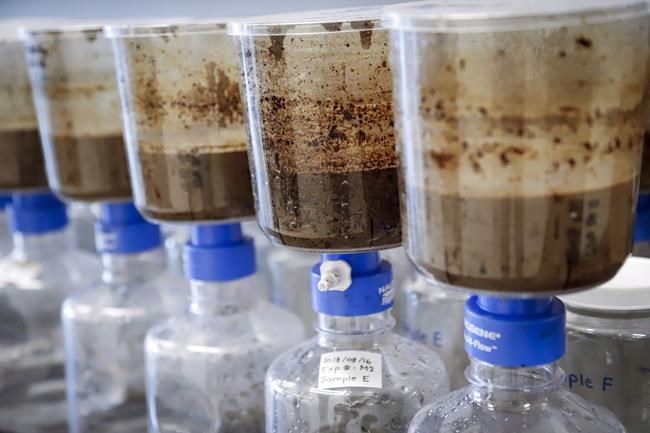
Tailings samples are being tested during a tour of Imperial's oil sands research centre in Calgary on Tuesday, Aug. 28, 2018. A Calgary-based lawyer says Alberta's energy regulator may have ignored provincial law by not publicly disclosing that waste from a large oilsands tailings pond was escaping containment and seeping into groundwater. THE CANADIAN PRESS/Jeff McIntosh
Republished March 07, 2023 - 1:17 PM
Original Publication Date March 06, 2023 - 11:06 AM
CALGARY - Alberta's energy regulator may have ignored provincial law by not publicly disclosing that waste from a large oilsands tailings pond was escaping containment and seeping into groundwater, says a lawyer.
Drew Yewchuk of the University of Calgary's Public Interest Law Clinic is asking the province's Information Commissioner to investigate how and why the Alberta Energy Regulator chose not to release information on the leak at Imperial Oil's Kearl mine, despite direction in provincial law to do so.
"How do decisions about what gets reported get made?" asked Yewchuk. "They don't make any sense."
Last May, Imperial Oil reported to the Alberta Energy Regulator that it had found some brown sludge outside the boundaries of one of its Kearl tailings ponds. Over the following summer and fall, investigators determined that it had come from the pond and contained levels of several toxic contaminants that exceeded environmental guidelines.
Area First Nations were told about the original finding of sludge. However, neither they, nor the public, heard any further information until Feb. 6, when the regulator issued an environmental protection order after a second tailings release from Imperial — 5.3 million litres of wastewater that escaped a catchment pond.
Yewchuk points to sections in the Freedom of Information and Protection of Privacy Act that say any public body is obliged "without delay," to inform the public about any "risk of significant harm to the environment or to the health or safety of the public" or any information "clearly in the public interest."
That provision is to override any of the act's exceptions to mandatory disclosure, including risk of financial harm to a third party.
"This is pretty obviously going to damage the environment," Yewchuk said. "Everyone knows that tailings are unreleaseably toxic."
In an emailed response, the regulator said it releases information to anyone who files a request for it.
"We are required to give our information to anyone who makes a request under the Freedom of Information and Protection of Privacy Act," wrote spokeswoman Karen Keller.
"The AER will continue to provide updates to potentially affected communities and is actively monitoring the situation at the Kearl site for Imperial’s ongoing compliance to the order," the regulator said in an earlier statement Monday.
Imperial has maintained that the releases were contained and posed no threat to water or wildlife.
"Extensive and ongoing water monitoring has confirmed that seepage has not entered local waterways," it said in a release Monday.
"There have been no impacts to local drinking water sources. There is no indication of impact to wildlife."
The Athabasca Chipewyan First Nation, downstream from the spill, has photographed moose tracks going into the affected area. That First Nation, along with the Mikisew Cree and the government of the Northwest Territories, have expressed anger and frustration with how they were informed about the releases.
On Monday, Alberta Premier Danielle Smith said it was "unfortunate" that none of those governments were informed.
She said, however, that there was never any environmental threat and the province's environment department said none of the tailings got into tributaries.
"I think the regulator did its job by demanding a very quick resolution to this and (I am) pleased that all parties are now coming forward," Smith said.
New Democrat Opposition leader Rachel Notley questioned Smith on the issue in the provincial legislature Monday.
"Proper monitoring, public safety and public notice are among the most basic government responsibilities in these situations," Notley said. "The (United Conservative Party government) failed at all of them."
Smith said the environmental concerns were overblown, fuelled by misinformation in the media.
Neither the Alberta government nor the two federal departments — Environment and Fisheries and Oceans — that have relevant regulatory responsibilities have responded to repeated questions about when they learned of the spills.
Yewchuk noted that in other cases involving small releases, the regulator has posted information on them immediately. It did so again on Monday, posting an order concerning an unknown release from a well owned by Everest Resources.
He questioned why the same wasn't done for the Kearl release.
"The information commissioner can look at those records in the original and provide a public report on what happened within the (regulator)," said Yewchuk. "I'd like to see those powers get used."
Smith said the regulator and the company share responsibility for informing the public — but the onus is "principally on the company."
Meanwhile, Imperial said the cleanup is proceeding.
"All impacted surface ice and snow in the area has now been removed and safely disposed," said a Monday release from the company.
Imperial said the seepage is primarily natural groundwater and precipitation with a "small amount" of tailings. It is installing monitoring and collection wells, surface pumps and additional drainage collectors to prevent a further release.
Company vice-president Simon Young offered his "deepest apologies" for the spills.
"We are taking all necessary steps to prevent this from happening again," he said.
This report by The Canadian Press was first published March 6, 2023.
— By Bob Weber in Edmonton
News from © The Canadian Press, 2023